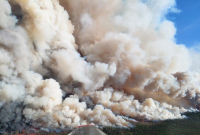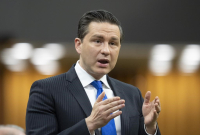Support strong Canadian climate journalism for 2025
Climate change does not recognize borders. Proof can be found in the smoke from Canadian fires that recently fouled the air in the United States and the catastrophic flooding of B.C.’s Sumas Prairie when the Nooksack River in the U.S. burst its banks in 2021.
Yet, efforts to fight climate change are often siloed by ecologically artificial borders between countries, provinces and states. Now a Victoria- and Seattle-based initiative known as Regenerate Cascadia is reimagining how we should organize and collaborate in the fight against climate change.
The Cascadia bioregion is 2,500 kilometres long and includes B.C., Washington, Oregon, Idaho, parts of southeast Alaska and northern California. It is defined by its geographic boundaries and unique watersheds, climate, flora and fauna, and faces a set of distinct environmental problems that directly impact its communities.
Given community knowledge of their own ecosystems, no one is better equipped to protect the bioregion than those who call it home, said Brandon Letsinger, founder of Cascadia Now and Cascadia Department of Bioregion.
“The idea of nestled communities is that we're all a part of a larger system,” said Letsinger. "Nature acts on the scale of watersheds, ecoregions and bioregions, so it's really important that when we talk about [natural] disasters, whether it's drought, flooding, earthquakes or wildfires, to have bioregional solutions for addressing these issues. And no state or province will ever be able to do that alone."

Regenerate Cascadia is working to address the social and cultural causes of the climate crisis in an effort to undo the cultural and ecological damage caused by colonization and overconsumption. Letsinger partnered with Victoria artist and cultural animator Clare Attwell to start Regenerate Cascadia, and the two were presented with an Edge Prize for their work. The Edge Prize recognizes rural, Indigenous and traditionally marginalized communities as sources of solutions and inspiration.
Regenerate Cascadia takes a bioregional approach to solving environmental problems and aims to restore a reciprocal relationship between humans and the ecosystems they live in. Bioregionalism argues colonial boundaries ignore the natural boundaries of ecosystems and how local communities interact with those ecosystems. Instead of addressing environmental problems at a municipal, provincial or national scale, Regenerate Cascadia begins by helping communities protect and restore their watersheds, which provide them with clean water, fresh air, food and other resources.
Through Regenerate Cascadia, Letsinger and Attwell hope to connect communities and environmental stewardship groups throughout the Cascadia bioregion already working to protect and restore the ecosystems that sustain them.
“There are so many people active and doing amazing work, who maybe aren't even familiar with [others] a couple of miles away that are doing similar work,” said Letsinger. “We want to connect and empower people and enable those who are doing that work to do it more effectively.”
Regenerate Cascadia has partnered with the Design School for Regenerating Earth to visit communities throughout the Cascadia bioregion during a Bioregional Activation Tour that will take place Oct. 1 to 31. This tour will allow communities to share their ideas and workshop ways in which they can protect and restore their home ecosystems. The tour will culminate in an in-person and online Bioregional Summit from Nov. 4 to 12 — a chance for these communities to come together and share ideas for how they can protect the Cascadia bioregion.

Joe Brewer, founder of the Design School for Regenerating Earth, conducted a similar project with locals in Barichara, Colombia, to re-establish a healthy and functioning 500-hectare bioregion. His work in Barichara involves both ecological restoration, such as reforesting and planting of endemic species, and cultural healing, where Brewer looks to locals and Indigenous communities for ways in which humans can live sustainably within the bioregion.
Now, Brewer is applying what he is learning in Barichara to bioregions throughout North America. Brewer has already completed two Bioregional Activation Tours in the Great Lakes and Colorado River bioregions. He is now helping to organize the Regenerate Cascadia tour that will include stops in Vancouver and Victoria in B.C., Seattle, Bellingham and the San Juan Islands in Washington, and Portland and Eugene in Oregon.
Bioregionalism is the counter to a globalized economy where wealthy nations extract resources from other countries without suffering the environmental impact of their unsustainable practices. Brewer believes we should model the human economy on how natural ecosystems work by only using the resources that are provided by our bioregion. By reconnecting with the places we live and recognizing the services they provide, Brewer believes we can begin to address the root causes of climate change.
“Climate change is a symptom of broken economic systems,” said Brewer. “One of the ways that we can begin to address this socially is by the way that we work with children. Helping children to connect with nature and restoring patterns of Indigenous spirituality, where the landscape itself is [considered] part of our extended family.”
Brewer, Letsinger and Attwell share a vision of decolonizing social systems and the ways in which we address climate change. They hope that through the Cascadia Bioregional Activation Tour and Bioregional Summit, they will help connect others who share this vision and create a network of groups working towards the common goal of restoring ecosystems throughout Cascadia.
“In the long term, I think it really is about people coming out and being actively engaged and helping communities gain ownership and have a say in policies that impact their lives,” said Letsinger. “[Regenerate Cascadia] really is about the tools that every person can walk out with, digging their garden, growing their food, connecting pollinator pathways and then all of that working together to create sustainable bioregions.”






Comments